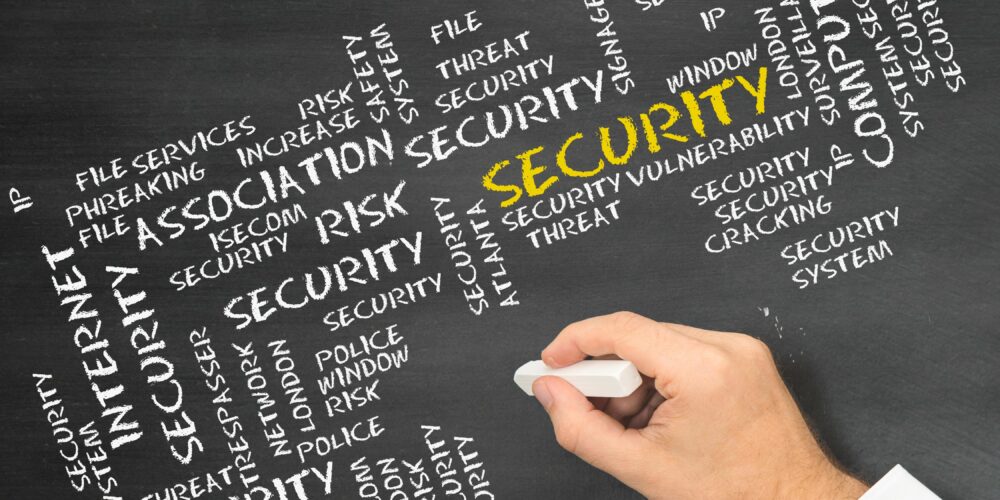Cybersecurity Risks for Physical Security Systems
Being proactive is the first line of defense in protecting yourself. Understanding the cybersecurity threats to mitigate them is important.

A survey conducted by Genetec states that 36% of responders said they were looking to invest in cybersecurity-related tools to improve their physical security environment.
Well, this shows that being proactive is the first line of defense, and understanding the cybersecurity threats to mitigate them is important. A physical security system keeps your facilities, assets, and people safe.
Due to work and paradigm shifts, physical security has become increasingly connected and integrated with networked devices and software. This means they are more vulnerable to cyber-attacks now than they’ve ever been before.
Now, you must be curious to know what are the primary threats to physical security systems. Well, below are some key cybersecurity risks to physical security systems:
- Unauthorized access: Hackers may attempt to gain unauthorized access to physical security systems by exploiting vulnerabilities in networked devices, software, or weak authentication mechanisms. The global physical security market size was valued at $127 billion in 2022 and is expected to grow at the rate of 6.8% from 2023 to 2030. This physical security cybersecurity example shows that the risks to the physical security system are more today than before.
Once they gain access to the system, they can manipulate security controls, disable alarms, or tamper with surveillance footage.
- Data breaches: Physical security systems often collect and store sensitive data, such as access logs, video footage, or employee information. If desktops and servers located in public places are left unattended, they can be easily unlocked. Data breaching can occur if an attacker successfully infiltrates the system and gains access to this data.
- Denial-of-Service (DoS) attacks: A DoS attack aims to disrupt the normal functioning of a physical security system by overwhelming it with a flood of network traffic. For example, attackers do this by sending more traffic than the target can handle. This causes it to fail—making it unable to provide service to its normal users.
Some physical security cybersecurity examples of the targets might include email, online banking, or websites. This can render the system ineffective, leaving vulnerabilities exposed and potentially allowing unauthorized access or physical breaches.
- Malware and ransomware: As per studies, 300,000 new malware are being created every day and a hacker attack occurs every 39 seconds. Malicious software can infect physical security systems through various means, including infected files, compromised devices, or malicious links.
Physical security systems often rely on network connectivity for monitoring, control, and remote access. If the network infrastructure supporting these systems is compromised, attackers can exploit weaknesses to gain unauthorized access. Once inside the network, they can deploy malware or ransomware to target the physical security devices and compromise their functionality.
- Insider threats: Insiders, such as disgruntled employees or contractors, can pose significant risks to physical security systems. For example, Malware and ransomware attacks can also occur through insider threats. A disgruntled employee, contractor, or someone with authorized access may intentionally introduce malware or ransomware to disrupt operations and steal sensitive information. Insider threats can be challenging to detect as they often have legitimate access rights.
One dramatic recent physical security example that highlights the importance of addressing cybersecurity risks for physical security systems is the Jan. 6, 2021, Capitol riot.
Despite numerous warnings and evidence on social media indicating an impending attack, the lack of preparation and inadequate security measures by Capitol officials led to a disastrous breach. As a result, rioters were able to storm the building, causing five deaths and forcing congresspeople to flee.
This incident serves as a poignant reminder of how cyber attacks can exploit vulnerabilities within interconnected physical security systems.
Now you understand the primary threats to physical security, let’s get to the best practices for cybersecurity in physical security systems.

Best Practices for Cybersecurity in Physical Security Systems
As organizations strive to safeguard their assets and protect them against evolving threats, implementing best practices for cybersecurity in physical security systems has emerged as a critical necessity.
By establishing a strong foundation of cybersecurity principles, adopting proactive strategies, and implementing AI services for your cyber security solutions, you can fortify your defenses and mitigate potential vulnerabilities.
Head below to the best practices you should consider when securing your physical security systems in the face of cyber threats.
-
Network Segmentation
Effective network segmentation is crucial to protect physical security systems from unauthorized access and potential cyber threats. By separating these systems from the corporate network, you can create an additional layer of defense.
One of the key practices for network segmentation includes allowing specific user permission for data access. For example, you can allow users to access some network resources that permit them to carry out their responsibilities while restricting access to sensitive data.
By implementing network segmentation this way, you can create distinct network zones dedicated solely to physical security systems.
For example, a large manufacturing facility can employ network segmentation to separate its access control and surveillance systems from its corporate network. This will ensure that even if one network segment were compromised, it would not affect other critical systems.
In addition, implementing firewalls, access control lists (ACLs), and virtual LANs (VLANs) is another approach used to control traffic.
- Virtual Local Area Networks (VLANs) can be used to logically separate and manage network traffic between different physical security components.
- Firewalls play a crucial role in enforcing access control policies and protecting against unauthorized communication between different network segments.
- ACLs can enforce security policies, restrict unauthorized access, and reduce the risk of unauthorized data breaches or malicious activities
According to an article by N-Able, implementing network segmentation through VLANs proves to be a valuable strategy in promoting streamlined communication and maximizing productivity across diverse departments within an organization.
-
Regular Patching and Software Updates
Establishing a regular patch management process involves systematically reviewing, testing, and applying patches and updates to physical security systems. It helps you stay up to date with the latest security fixes and ensures that vulnerabilities are addressed in a timely manner. Key practices in this process include
- Patch assessment and prioritization for immediate application
- Testing patches to ensure they do not cause any compatibility issues or system disruptions
- Scheduled patch deployment to ensure that patches are consistently applied to physical security systems
- Vendor communication and monitoring to promptly identify and address any vulnerabilities
Implementing a robust patch management process reduces the attack surface and minimizes the risk of successful cyberattacks on physical security systems.
It demonstrates a proactive approach to security and helps organizations stay resilient in the face of evolving threats.
In addition to this, keeping software and firmware up to date is equally important. Regularly update the operating systems, firmware, and software applications used in your physical security systems. Enable automatic updates wherever possible to ensure you receive the latest security patches promptly.
Why is it so important? Because outdated software and firmware can contain known vulnerabilities that cybercriminals can exploit. By regularly updating them, you ensure that any identified security weaknesses are addressed promptly, reducing the risk of potential breaches.
According to a study in 2021, two of the primary obstacles preventing companies (worldwide) from enhancing their cyber resiliency are their struggle to update their software applications followed by delayed patching.
Thus, by prioritizing regular patching and software updates, organizations can effectively mitigate known vulnerabilities and strengthen the security posture of their physical security systems.
-
Strong Authentication and Access Control
By enforcing strong authentication protocols, you can ensure that only authorized personnel can access critical systems. Key practices include:
- Implementing multi-factor authentication for system access: Require users to provide multiple forms of identification, such as passwords, biometrics, or security questions, to authenticate themselves and gain access to physical security systems. According to a survey conducted in 2022, passwords remained the primary security factor utilized by companies globally.
- Restricting user privileges and employing role-based access controls: Grant users only the necessary privileges based on their roles and responsibilities. Implement role-based access controls to limit access to sensitive functionalities within the physical security systems.
-
Encryption and Data Protection
When it comes to encryption and data protection in physical security systems, the following practices should be implemented:
- Encrypting data transmissions and storage: It is essential to employ encryption protocols to protect data as it traverses between different components of the physical security system. Encrypting data in transit, even if intercepted, it remains inaccessible to unauthorized individuals. For instance, Internxt’s secure cloud services incorporate robust encryption mechanisms that safeguard data during transit and at rest. This ensures that users’ files remain encrypted and secure, mitigating the risk of unauthorized access.
- Implementing secure protocols and algorithms: To uphold the confidentiality and integrity of data within physical security systems, it is crucial to employ industry-standard encryption protocols and strong cryptographic algorithms. These protocols and algorithms form the foundation of secure data transmission and storage, minimizing the risk of data compromise.
By implementing encryption and data protection measures, including leveraging secure protocols and algorithms, physical security systems can maintain the confidentiality and integrity of data.
Additionally, incorporating products like Internxt’s secure cloud services further enhances the overall safety and security of sensitive information. With Internxt, you have the assurance that their files and privacy are prioritized, enabling them to take control of their data with confidence.

Compliance and Regulatory Considerations
The number of data breaches is increasing, costing companies billions annually, and cybercrime is predicted to cost $10.5 trillion by 2025. Businesses need cybersecurity professionals to stay ahead of hackers and protect against cyberattacks. Here are key considerations for compliance and regulatory alignment:
- Understanding relevant compliance requirements and regulations:
-
-
- Identify the specific regulations and standards that apply to your industry and physical security systems.
- Examples include the General Data Protection Regulation (GDPR), Payment Card Industry Data Security Standard (PCI DSS), and various data protection laws.
-
- Incorporating compliance frameworks and standards into cybersecurity practices:
-
- Implement controls and measures outlined by applicable compliance frameworks.
- Ensure adherence to security guidelines and best practices provided by regulatory bodies or industry-specific organizations.
By prioritizing compliance and regulatory considerations, you can align your cybersecurity practices with legal obligations and industry standards. This proactive approach reduces the risk of non-compliance penalties and enhances the overall security posture of physical security systems.
Remember, maintaining GDPR compliance is an ongoing process that requires regular assessments, updates, and adherence to evolving regulatory frameworks.
Organizations can create a solid foundation for protecting physical security systems while meeting their legal and regulatory requirements.
Conclusion
In today’s interconnected world, ensuring the cybersecurity of physical security systems is paramount. By following best practices, you can fortify your defenses against cyber threats. Real-life physical security cybersecurity examples demonstrate the effectiveness of these measures in protecting physical security systems.
As technology continues to evolve, embracing emerging trends like AI and IoT security will be essential to stay ahead of potential risks. Let us prioritize cybersecurity in our physical security strategies to safeguard our assets, protect our people, and ensure a safer future.
Remember, the security of our physical systems relies on our commitment to cybersecurity. Let’s take action today to secure our future.
Charu Gupta is an outreach specialist with more than four years of experience in digital marketing. Her expertise lies in developing and executing outreach campaigns that drive engagement and build brand awareness. When she’s not brainstorming outreach ideas, you can find Charu exploring the outdoors or practicing yoga.
If you enjoyed this article and want to receive more valuable industry content like this, click here to sign up for our FREE digital newsletters!

Security Is Our Business, Too
For professionals who recommend, buy and install all types of electronic security equipment, a free subscription to Commercial Integrator + Security Sales & Integration is like having a consultant on call. You’ll find an ideal balance of technology and business coverage, with installation tips and techniques for products and updates on how to add to your bottom line.
A FREE subscription to the top resource for security and integration industry will prove to be invaluable.







